Circuit explanation
for Step-up converter
(MC34063A)
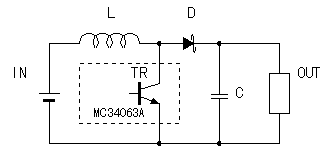 The circuit on the left is the basic circuit of the step up converter. The operation of the step up converter resembles the situation when opening the stopper of the swollen balloon suddenly. It slips force well the electrical energy(Air) which was stored up at the coil(Balloon) on the side of the output at the time of TR is OFF(Open the stopper) and it makes the voltage rise. 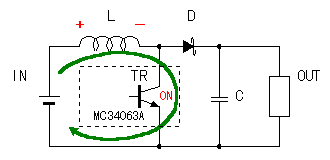 The energy is stored up at the coil when TR becomes the ON condition. At this time, the side of the input of the coil becomes positive and the side of the output becomes the negative potential. 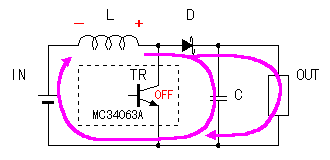 When TR becomes the OFF condition, the coil tries to continue to pass the electric current(Lenz's law) and slips the stored energy. At this time, the side of the input of the coil becomes negative and the side of the output becomes the positive potential. Because TR is OFF, the electric current flows through the capacitor (C) and the load through the diode (D). 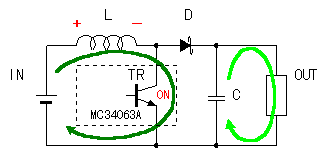 The energy is again stored up at the coil when TR becomes the ON condition. The electric current flows through the load with the energy which was stored up at the capacitor. The energy which was stored up at the capacitor doesn't flow through TR for the diode (D) and flows only through the load. In case of this method, when the energy to consume in the load is bigger than the energy which the coil stores up, the output voltage doesn't rise. When the energy which the coil stores up is big, the energy which is stored up at the capacitor increases and the voltage rises. The regulator is watching over the output voltage. It controls to stop the switching operation and for the output voltage to become constant when becoming the set voltage. 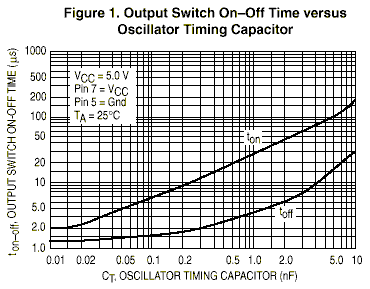 The figure on the left is the chart which shows the relation between the timing capacitor and the switching time which is mentioned to the data sheet. The figure on the left is the chart which shows the relation between the timing capacitor and the switching time which is mentioned to the data sheet.The circuit which was made this time used the 1500-pF capacitor. In this case, it becomes ton=40µS, toff=5µS. Because it is, the frequency is f = 1/(ton+toff) = 22kHz. I used the value which is mentioned to the sample circuit of the data sheet as the value of the capacitor. I think that the high frequency can do the coil and so on smaller. However, because the high-speed switching made the loss of the switching transistor and the diode big, I used the value of the data sheet. The inductance value of the main coil (L1) concerns the efficiency of the regulator directly. The big inductance can send a lot of energy to the output. But, when the inductance is big, the high voltage occurs in the both edges of the coil when TR becomes OFF. The too big inductance destroys TR(VCEmax=40V) in the high voltage which occurs to the coil. I could not understand the calculation formula which finds the inductance value which is mentioned to the data sheet. So, I used the inductance which is near the value of the sample circuit. L(min) = ((Vin(min) - Vsat) / Ipk(switch) ) x ton(max)
There is an effect in the value of the capacitor in the bigger one. You must consider the use because the size of the capacitor with the big capacity is big and the many inflow electric currents occur. Because the big charging and discharge electric current flows through this capacitor, you use the small one of the ESR(Equivalent Series Resistance). There is a way of connecting the capacitor in parallel as the means of making the ESR small. 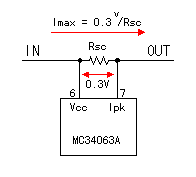 MC34063A can prevent the destruction by the over-current by detecting the input electric current. MC34063A can prevent the destruction by the over-current by detecting the input electric current.The over-current is detected by the voltage drop of the resistance which is put in the input circuit in series. The regulator judges the over-current when the voltage difference between Vcc and the over-current detection terminal(Ipk) is more than 0.3 V and limits the supply of electric power to the output. Because I used the 0.22-ohm resistor at the circuit this time, as the input current limiting value, it becomes 0.3V / 0.22ohm = 1.36A. I make the connection between the side of the output of R1 and the 7th pin of the regulator the independent pattern on the printed board. This is to more correctly detect the voltage which is applied to R1. The sheet copper of the printed board is small but has the resistance value. When few electric currents occur, the voltage drop with the printed board can be ignored. Because the over-current detection detects the voltage of the milli-volt, when the electric current is big, the voltage drop of the printed board can not be ignored. I connect the pattern with the side of the output of R1 directly and prevent the influence of the big electric current which flows through the printed wiring. 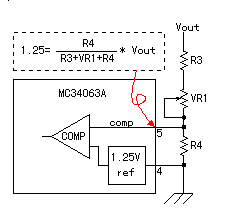 MC34063A compares the reference voltage of 1.25-V and the output voltage and is controlling the output voltage to be constant. The output voltage can be calculated by the following formula.
Vout = ((R3+VR1+R4)/R4)x1.25
At the circuit this time, R3 = 33k-ohm, R4 = 3.3k-ohm, VR1 = 50k-ohm, it changes as follows in the output voltage by the change of VR1.
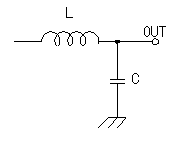 As for the switching regulator, the switching frequency ripple appears in the output. You can make the ripple little in making the capacitor (C2) which connects with the output big. I prepare another ripple filter for the output with the circuit this time and make the ripple little. As for the switching regulator, the switching frequency ripple appears in the output. You can make the ripple little in making the capacitor (C2) which connects with the output big. I prepare another ripple filter for the output with the circuit this time and make the ripple little.The sample circuit of the data sheet is using the 1µH one as the coil. I used the 25µH one. Because, I could not acquire the coil of 1µH, 2A. When the inductance value is big, the filter is effective but the efficiency rather falls. The toroidal coil can be made by yourself, too. |